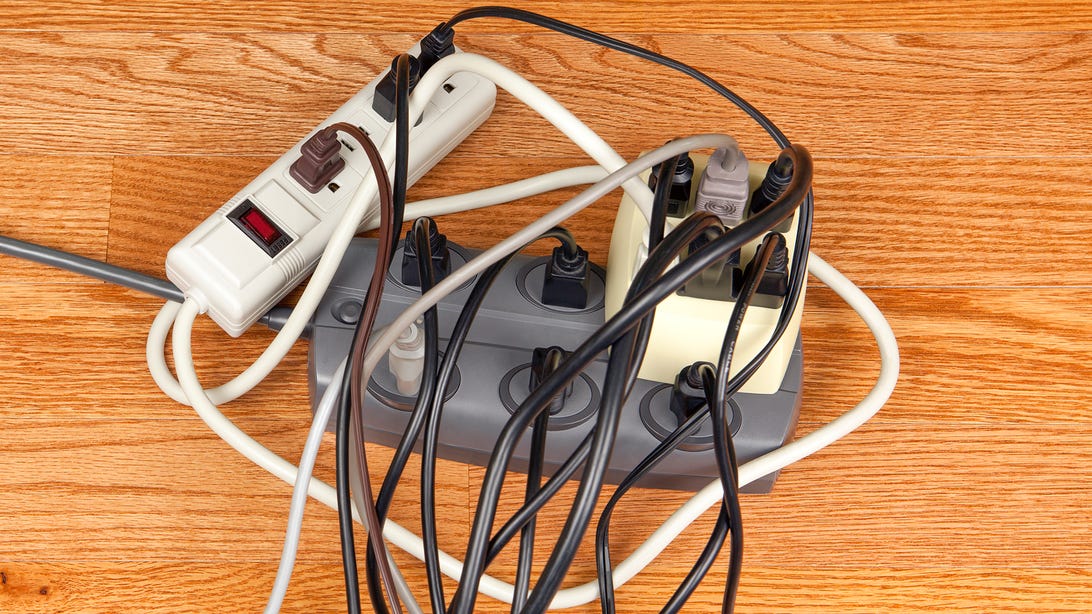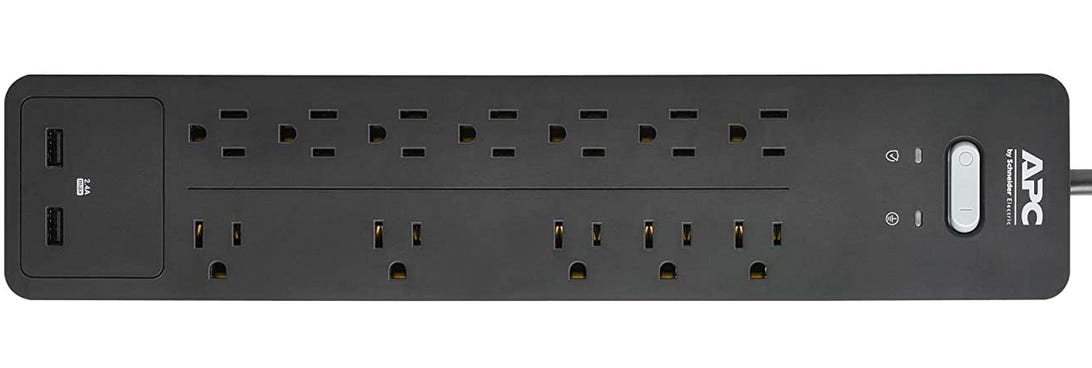What to Look for in a Surge Protector

You probably take more devices that demand charging than wall outlets to charge them. Adding additional AC outlets and USB charging ports is one benefit of surge protectors, just many models likewise add a layer of protection against a random, but surprisingly mutual, power surge. These spikes in power can damage your gear, and so a layer of separation between them and the power in your wall is a proficient matter.
Not all surge protectors are created equal. In that location's a broad range of prices and a handful of features to consider. Many come up with questionable marketing promises, also, so it'south hard to figure out what's worth the money and what'southward nonsense. I'll help you lot sort through it.
While you're here, we've got tips on hiding Boob tube wires and products that assistance cut cord ataxia. Plus, quick tweaks that will heighten your home theater setup. If yous're interested in a scrap of groundwork, check out what makes a skilful surge protector. This article is the updated successor to that one and covers the basics you need, and then permit'south dive in.
1. Surge protectors vs. power strips

Belkin Surge Power Strip Protector
Tyler Lizenby/CNETPower strips and surge protectors, as well called surge suppressors, are different.
Typically, power strips are inexpensive, multi-outlet products that are merely an expansion of a wall outlet. They're unremarkably small and sparse, sometimes fitting directly into the outlet itself. They usually have a circuit breaker (on/off switch) of some sort, but most don't offer any existent "protection" from electrical problems. Some might have the barest level of protection, simply they're all pretty much only like plugging into the wall directly.
Surge protectors are relatively cheap too, simply different ability strips they offer some level of protection against ability spikes. How much and how well varies considerably. They're usually a bit more elaborate, and often bigger, than a simple power strip, though not ever.
2. Joules are a mensurate of protection

Aye, non sure what to do nigh that either, buddy.
Getty Images - D-KeineSurge protectors offer protection in units called joules. Mostly, the more joules the better, equally this means the device can handle one large surge, or multiple smaller surges, before your gear is in danger. Over time, the parts within the protector wear downwards, reducing its effectiveness.
Unfortunately, there'southward no fashion to know how much protection a device has left, or if the initial rating is fifty-fifty accurate. Buying from a reputable company, and one that includes a warranty, is a good idea.
iii. Some come with a warranty on your stuff

Some surge protectors offer a warranty (upwards to a certain amount) on the gear connected to the protector. For example, in the United states, certain Belkin models have up to $300,000 Continued Equipment Warranty, and states: "Belkin Components will repair or replace, at its option, any equipment which is damaged by a transient voltage surge/fasten or lightning strike, (an "Occurrence"), while properly connected through a Belkin Surge Protector to a properly wired AC power line with protective ground."
You'll probably never need information technology, only it certainly doesn't injure to have it. Proceed in heed, still, that just because the warranty exists doesn't mean you'll ever encounter a dime from information technology. Note in that Belkin quote the term "at its option." That ways they'll come up up with whatsoever reason not to encompass your claim. So don't use this every bit a replacement for home or renter'south insurance.
4. Why you probably don't need a power 'conditioner'
At that place are a number of products on the market that claim to "condition" the ability from the wall, promising improved performance in your gear.
Here'south the muddy piddling surreptitious: Your gear already does this. All electronics have a power supply that takes the incoming wall current (120v in the US), filters it for noise, and converts it into whatever the device needs. Almost cipher actually runs on 120 volts (or alternating electric current, for that matter), and so unless you've got some really wacky (or cheap) gear, and alive in an expanse with bizarrely inadequate power, a power conditioner isn't something y'all need.
5. Always get more outlets than you demand right at present

You're always going to need more outlets. You'll undoubtedly add more gear, without necessarily getting rid of your current gear. I'm not maxim that if you call back you lot need four outlets, you should get 12 -- but at least six is probably a adept investment.
Ideally, you don't want your surge protector to look similar the image above.
vi. Get one with plenty spacing for big plugs

APC Surge Arrest P11U2
APCNear modern devices utilise "wall warts" -- plugs that convert Ac power into DC power and expect like little boxes with electrical prongs sticking out. Consider getting a surge protector with wider spacing between sockets, or sockets that can be rotated or moved, to arrange chunky plugs.
Note how the APC example in the image above has several close-spaced outlets, for small-scale plugs, and besides 6 wide-spaced for wall warts.
seven. Power spikes can come to phone or cable lines, too
If you want total protection, consider that phone and cable lines tin carry power spikes, likewise. Some surge protectors have connectors for these also.

Sorry, doggo.
Getty Images - Ирина Мещеряковаeight. USB is swell, simply check the amps

APC Surge Protector with USB Charging Ports
APCMany surge protectors come with USB connections, and so yous tin charge your mobile devices without having to use their wall warts. Handy, for sure, merely check what the output amp rating is. Generally, this is either 1 or ii amps (often labeled 1A or 2A). This is how much flow you can get through the pipe, and so to speak. You'll want at to the lowest degree 2 amps for quicker charging.
Most modern phones have the ability to fast-charge, but you'll need to utilise their wall warts for that. If you don't need to quickly charge them, though, these lower power ports will piece of work just fine.

Watch this: USB-C gets large ability boost
ix. Traveling? Become a portable power strip
While not offer much protection, a portable ability strip might prevent marital friction, and/or invoke bliss from travel companions. Almost hotels and hostels have few accessible outlets, notwithstanding everyone has multiple devices that need recharging. About portable power strips add two to three additional outlets, plus offer direct USB charging (see no. 8).
ten. They don't last forever
Call up the joule rating nosotros discussed before? Well, it means that over fourth dimension, a surge protector is going to wear out. Some volition requite you a alarm or shut off when their protection drops below a safe level. Many will just keep working, without protection, and you lot won't know it until a power spike amercement your gear. If you know you've had a serious electric event (like lightning blew out a transformer down the street), information technology's probably worth replacing your surge protector but in case.
Most companies that sell surge protectors say they demand to be replaced every 3 to 5 years. Sure, they're motivated to have you buy them more often, but with many models under $50, this isn't an extreme cost.
Bottom line
There is no reason not to get a surge protector. How much you might need it will vary. If you live in an area with lots of thunderstorms, your gear is probably more likely to feel power surges. Fifty-fifty if you lot live in the desert, your A/C or refrigerator could kick power spikes back down the lines to your A/V gear.
One thing that's across the scope of this commodity, simply worth mentioning, are UPSs, or uninterruptible power supplies. These are like surge protectors, just have built-in batteries so the device never loses ability. At to the lowest degree, non until the battery runs down. They're not crucial for most people and nearly equipment, only if in that location'due south something in your business firm that would cause serious issues if it lost ability (CPAP machines, perhaps), they're worth looking into. Just make sure they fit your specific needs.
Since most surge protectors are cheap, they're worth getting (and regularly replacing) simply in case.
Note that CNET may go a share of the acquirement if yous buy anything featured on our site.
Besides as covering TV and other display tech, Geoff does photo tours of cool museums and locations around the world, including nuclear submarines, massive aircraft carriers, medieval castles, aeroplane graveyards and more.
You tin can follow his exploits on Instagram and his travel video series on YouTube. He also wrote a bestselling sci-fi novel about metropolis-size submarines, along with a sequel.
gonzaleseilteradde.blogspot.com
Source: https://www.cnet.com/tech/home-entertainment/not-all-surge-protectors-are-created-equal/
0 Response to "What to Look for in a Surge Protector"
Post a Comment